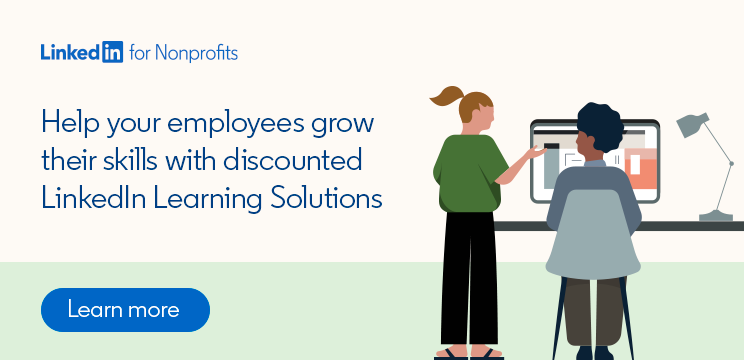
Follow These Tips to Keep Nonprofit Talent from Burning Out
You may already be familiar with the signs of a nonprofit employee experiencing burnout. You may even have experienced it yourself. This state is reached when someone feels overwhelmingly stressed and exhausted as a result of their job, often leading them to no longer find value or fulfillment in their work.
It’s critical for leaders and managers in all sectors to vigilantly guard against burnout. The urgency is even more pronounced for nonprofits, where employees often feel a strong emotional connection to the work they do that can make it harder for them to set healthy boundaries. Fortunately, there are proven ways to keep nonprofit burnout at bay.
Employee burnout is a problem for nonprofits
Global research conducted by McKinsey & Company in 2022 found that nearly one in four employees were experiencing burnout symptoms — resulting in six times more employees wanting to leave their jobs in the near future. “While burnout affects workers in all sectors around the world, nonprofit organizations appear to be among those particularly vulnerable to it,” McKinsey notes.
As an example, McKinsey points to the social sector in Australia, which has grown overburdened by dramatic increases in demand for services like mental health support, food banks, and crisis response in the past five years. When asked to assess their stress levels, 88% of surveyed nonprofit leaders self-identified as “in orange” or “in red” zones, indicating a high risk of burnout.
Symptoms of employee burnout can be easy to miss, especially in hybrid or remote workplaces. But through awareness and action, nonprofit leaders and managers can help turn things around.
Symptoms of employee burnout
To identify signs of burnout in your nonprofit workforce, keep an eye out for sustained changes in behavior. Everyone has tough days, but a nonprofit employee showing ongoing signs of dissatisfaction or disengagement is cause for concern. Look out for these common indicators that an employee might be experiencing burnout:
Lack of energy: They often seem tired and struggle to focus or complete tasks.
Distance or alienation: People who were once talkative in the workplace or on your team’s communication platform become noticeably more withdrawn.
Less participation: They show up to work less frequently, or are less likely to take an active role.
Reduced enthusiasm: They are less likely than before to speak positively about your nonprofit and its cause on social media and elsewhere.
Lower satisfaction scores: Employee experience surveys show a downward trend.
Employee burnout can be very difficult to detect, as team members may try to push through it and hide how they’re truly feeling. Sometimes, an individual won’t recognize that they’re dealing with burnout until it’s too late.

“Don’t wait for people to speak up if they’re struggling,” Steph Cousins, Global CEO of the nonprofit Talent Beyond Boundaries, suggests in the Moving Forward newsletter. “Instead, ask about their work-life balance, stress, and general wellness on a regular basis.”
Tips for preventing burnout at your nonprofit
As a nonprofit leader, there are several steps you can take to prevent and mitigate burnout on your teams. Follow these best practices to support employees’ well-being and continually reinforce their purpose-driven passion.
Rally around your cause and mission.
While employees are navigating the day-to-day stresses and pressures of their roles, it can be easy to lose sight of the bigger picture. Make a point of regularly calling attention to the impact of the work your team is doing — and why it matters. Help team members see that even on tough days, they are making a difference and it’s appreciated.
Provide resources and guidance for avoiding burnout.
Empower your people to take control of their work experience by creating awareness around burnout and what to do about it. Tips for managing burnout as a nonprofit professional include:
Breaking up big tasks into small chunks.
Prioritizing rest and self-care.
Avoiding comparing yourself to others.
Finding a strong support system.
Waiting 48 hours before making major decisions.
Encourage managers to check in with employees regularly, and equip them with best practices they can lean on if they suspect that a team member is approaching or experiencing burnout. This could include sharing helpful articles, advocating for the employee to take a mental health day, or reevaluating their workload together. If your organization uses LinkedIn Learning, managers could also share course recommendations, such as Combating Burnout with Mindfulness.

Support professional development and career growth.
While many people get into nonprofit work out of a sense of altruism, that doesn’t mean they want to stay in the same role forever. If employees feel like their career is stagnating or their skills are being under-utilized, this could contribute to or speed up burnout.
Providing meaningful growth opportunities can be a powerful way to keep team members engaged and minimize burnout. In fact, providing learning opportunities is the number one way that organizations are working to improve retention, according to the 2023 Workplace Learning Report from LinkedIn.
For a culture of continuous growth and learning to take hold, it can’t be an afterthought. Look for ways to incorporate learning into employees’ work days without it becoming a burden.
You can do this by ensuring that managers are having regular conversations with their direct reports about what skills they want to develop, outlining next steps, and discussing progress and roadblocks. You can also offer flexible learning resources, such as access to LinkedIn Learning, that employees can explore when it’s most convenient to them. That way, learning will remain energizing, rather than becoming a stressor.
Employee burnout may be common at nonprofits, but it’s not inevitable. By being responsive to the signs of burnout and proactive about putting strong support systems in place, you can minimize burnout and help your whole team to thrive.
Find out more about how LinkedIn Learning helps nonprofits engage and nurture their employees.

